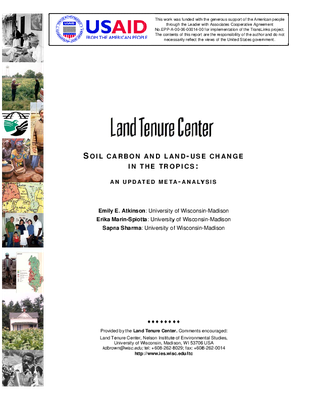Soil Carbon and Land Use Change in the Tropics: an Updated Meta-Analysis
ABSTRACT: Soil carbon stocks are a vital component of ecosystem services, particularly in the tropics. Recent attention has focused effects of land-use change in the tropics on soil carbon stocks to better understand how human activities have influenced the release of carbon from soils. We conducted an updated meta-analysis of data from 144 studies that measured soil carbon under different land uses across the tropics. Mean soil carbon stocks vary between dry (55 MgC/ha, <1000 mm MAP), moist (67 MgC/ha, 1000-2500 mm MAP), and wet (85 MgC/ha, >2500 mm MAP) climates with wet climates having the highest mean stocks for each land use. Overall, grasslands (604 MgC/ha) and cultivated sites (594 MgC/ha) have statistically significant lower soil carbon stocks than pastures (684 MgC/ha), which do not differ significantly from unconverted forests (803 MgC/ha) and secondary forests (842 MgC/ha). Using a regression tree analysis, we show that soil type and climate are the most influential factors in determining the fate of soil carbon during conversion from one land use to another. Hence, understanding a site’s environment is crucial for predicting the loss or gain of soil carbon. Our soil carbon meta-analysis revealed a number of challenges for comparing soil carbon stocks across studies. These include comparing soil carbon concentrations when differences in bulk density are unknown, variation in sampling depths and replication, and incomplete knowledge of site land use history. Addressing these challenges will enhance our understanding of rates of soil carbon sequestration and factors contributing to the fate of soil carbon.
https://biodiversitylinks.org/projects/completed-projects/translinks/translinks-2010/land-tenure-center/Paper_SoilCarbonAndLandUseInTropics.pdf/view
https://biodiversitylinks.org/projects/completed-projects/translinks/translinks-2010/land-tenure-center/Paper_SoilCarbonAndLandUseInTropics.pdf/@@download/image/image.png
File
Soil Carbon and Land Use Change in the Tropics: an Updated Meta-Analysis
Author(s):
Emily E. Atkinson,
Erika Marin-Spiotta,
Sapna Sharma
Publication Date: 2010
DOWNLOAD FILE
ABSTRACT: Soil carbon stocks are a vital component of ecosystem services, particularly in the tropics. Recent attention has focused effects of land-use change in the tropics on soil carbon stocks to better understand how human activities have influenced the release of carbon from soils. We conducted an updated meta-analysis of data from 144 studies that measured soil carbon under different land uses across the tropics. Mean soil carbon stocks vary between dry (55 MgC/ha, <1000 mm MAP), moist (67 MgC/ha, 1000-2500 mm MAP), and wet (85 MgC/ha, >2500 mm MAP) climates with wet climates having the highest mean stocks for each land use. Overall, grasslands (604 MgC/ha) and cultivated sites (594 MgC/ha) have statistically significant lower soil carbon stocks than pastures (684 MgC/ha), which do not differ significantly from unconverted forests (803 MgC/ha) and secondary forests (842 MgC/ha). Using a regression tree analysis, we show that soil type and climate are the most influential factors in determining the fate of soil carbon during conversion from one land use to another. Hence, understanding a site’s environment is crucial for predicting the loss or gain of soil carbon. Our soil carbon meta-analysis revealed a number of challenges for comparing soil carbon stocks across studies. These include comparing soil carbon concentrations when differences in bulk density are unknown, variation in sampling depths and replication, and incomplete knowledge of site land use history. Addressing these challenges will enhance our understanding of rates of soil carbon sequestration and factors contributing to the fate of soil carbon.



